#Thom Browne ready to wear spring 2017
Photo


Thom Browne ready to wear spring 2017
#Thom Browne ready to wear spring 2017#Thom Browne#bags#purses#fashion#fashion details#details#accessories
33 notes
·
View notes
Photo


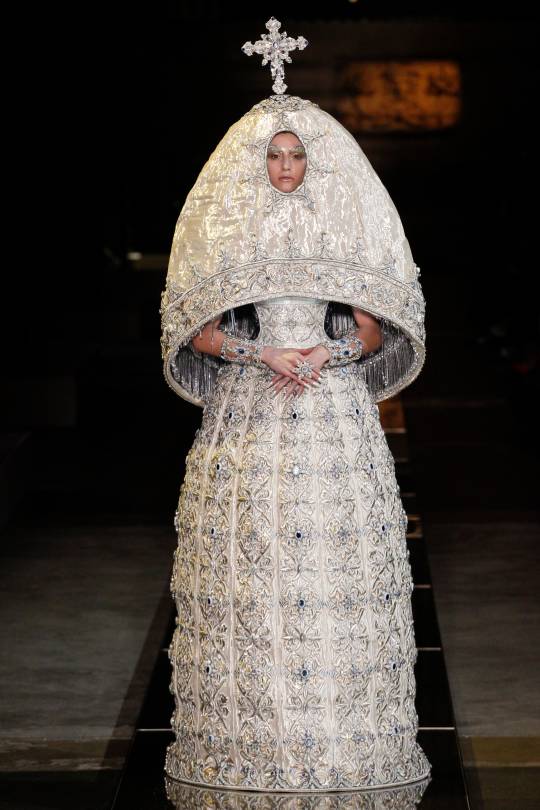

Moncler 1 Pierpaolo Piccioli Fall 2019 rtw ~ Thom Browne Spring 2018 rtw
Guo Pei Spring 2017 couture ~ Valentino Spring 2019 couture
#moncler#moncler 1#pierpaolo piccioli#moncler 1 pierpaolo piccioli#thom browne#fall 2019#rtw#ready to wear#spring 2018#fashion#runway#fashion inspiration#inspiration#runway inspiration#guo pei#valentino#spring 2017#spring 2019#couture
56 notes
·
View notes
Photo



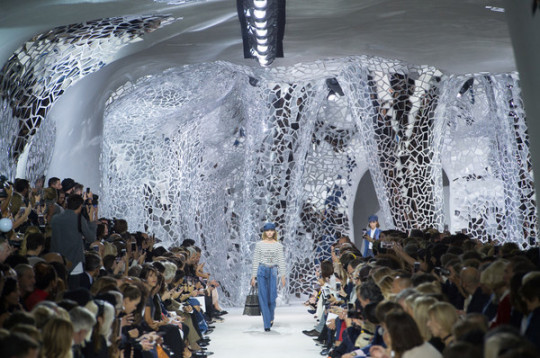
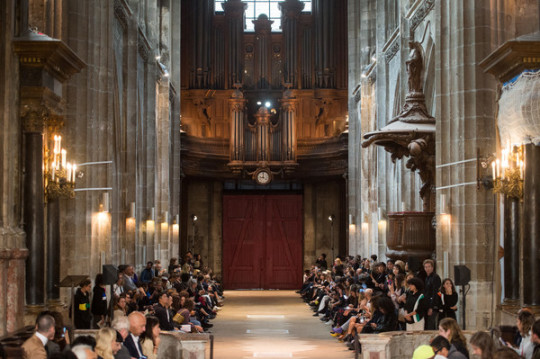

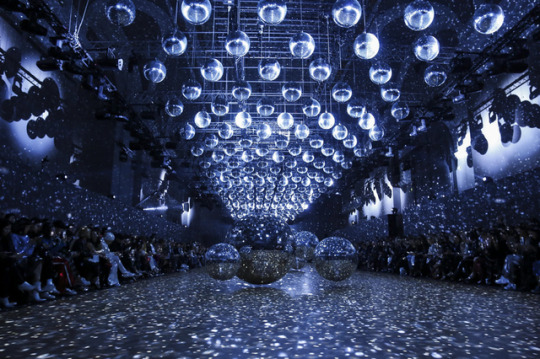



PARIS FASHION WEEK
Spring/Summer 2018 fashion show sets
(1) Alexander McQueen (2) Andreas Kronthaler for Vivienne Westwood
(3) Balmain (4) Dior (5) Koche (6) Lacoste (7) Moncler Gamme Rouge
(8) Rick Owens (9) Thom Browne (10) Saint Laurent
#fashion show set#fashion#pfw#scenography#ss 2018#runways#paris fashion week#Moncler Gamme Rouge#Lacoste#Rick Owens#Balmain#Dior#Saint Laurent#Koche#Alexander McQueen#Andreas Kronthaler for Vivienne Westwood#Andreas Kronthaler#Vivienne Westwood#Thom Browne
533 notes
·
View notes
Photo

0 notes
Text
Ralph Toledano Defends Fashion Weeks, Runway Shows – WWD
https://pmcwwd.files.wordpress.com/2020/06/rt_portrait.jpg?w=640&h=415&crop=1
Ralph Toledano has attended many, many runway shows — as head of brands including Guy Laroche, Karl Lagerfeld, Chloé and Nina Ricci, and in his current role as president of the Fédération de la Haute Couture et de la Mode.
Forced to cancel men’s fashion week and couture week in the wake of the coronavirus pandemic, French fashion’s organizing body is preparing for digital showcases in July hinged on films and videos. But it hopes to resume runway shows as early as this autumn, conditions permitting.
In an exclusive interview, Toledano articulated the value of the physical format, of fashion weeks, and the central place of Paris:
WWD: Let’s pretend you’re in a court of law, asked to defend the reputation and purpose of the runway show. How would you state your case?
Ralph Toledano: It is the very best incentive for the designer and his or her team to excel in every single aspect: design, materials, colors, construction, embellishment — not only for ready-to-wear, but also for shoes, bags, jewelry, beauty, etc. And the show is such a stimulant that the closer it gets, the more innovative and prolific the design team becomes.
For each house, it is the highlight of the season: a moment of fever, excitement, celebration, when everybody comes together to support the design team — a situation when everything becomes possible. And the show itself is an exceptional moment of excitement and buzz, as at a specific time, in the same place, you gather all the fashion experts to see — I would even say to feel, smell and practically to touch — the result of several months of hard and intensive work. The staff can’t wait for the show and no one would miss it for any reason.
It is quite emotional, and I do not think that we are even close to finding an alternative to a fashion show. This being said, the above applies only to brands who stand for creativity and workmanship, which is the hallmark of Paris.
WWD: That’s a lot of pros. Do you see any cons for runway shows or fashion weeks?
R.T.: Each season, more and more brands apply to be included in the calendar of Paris Fashion Week. It’s a unique moment for the industry, a kind of ceremony where we celebrate our passion for fashion and for creativity.
Regarding the cons, I would mention two. First, the cost. Even if there is a very wide range of budgets, shows are generally expensive. I think that in this very difficult period, we will see more intimate presentations in the federation’s’s calendar. They are generally very warm, have a special character, and allow social distancing.
The sustainability aspect has also been identified, sometimes exaggerated as, in terms of carbon footprint, Paris Fashion Week represents the equivalent of a small international music festival or event. Since a while, the federation has been active on this topic. Paris Fashion Week is getting greener every season, and we have been working on a bill of specifications with all the stakeholders — brands, producers, venues — in order to be more and more sustainable.
Additionally, we are developing a tool to find more sustainable alternatives at each step of the value chain. The goal is to improve the decision-making process from the conception to the dismantling of the sets.
The Set at Chanel Haute Couture, fall 2017.
Stéphane Feugère/WWD
WWD: How do you feel about “see-now, buy now” formats for the Paris shows?
R.T.: You and I have been discussing this topic already a few years ago, and on behalf of the federation, I listed all the reasons why for creative brands, it did not make sense. The facts proved that we were right. It may work for consumer-driven or lifestyle brands. These kind of brands may find relevant to organize a kind of entertainment event, highly Instagrammable.
WWD: How about coed shows?
R.T.: As long as the two lines are consistently designed, or if one of the two lines is underdeveloped, it may make sense for some houses. But in my opinion, it is more powerful and it gives more strength to each collection to show separately.
WWD: And how do you feel about digital formats in lieu of physical shows?
R.T.: All the fashion houses must be highly digitally minded, in each aspect of their organization. Regarding the shows, digital is becoming an interesting complement, and a possible alternative in very special circumstances — such as this awful period we are going through. It can be a real source of innovation for expressing creativity, and it is what we are working on for our men’s wear and couture online projects, which will take place in July.
But, as I mentioned previously, at least for the moment, nothing can replace the very special emotion of a fashion show in “real life.”
WWD: The CFDA and the BFC recently issued a statement saying “the fashion system must change, and it must happen at every level,” urging a slower pace and recommending “that brands attempt to show during the regular fashion calendar and in one of the global fashion capitals in order to avoid the strain on buyers and journalists of traveling constantly.” Do you agree with all that? Why or why not?
R.T.: I agree that the fashion system must change, and in several aspects, starting with the seasonality of deliveries and sales, a proposal well developed by Dries Van Noten and his task force. I think that fall-winter collections should be sold from August/September to February, and spring-summer from February/March to August — that is, during the periods when the customer wears those clothes. Sales would take place in September and March.
Discounting very early in the season should stop: It is the cancer of our industry. American department stores have started this kind of practice and have successfully exported it to the whole world. It is now very dangerously adopted by e-commerce pure players.
The bottom line is that after having tremendously damaged the excellent network of American specialty stores, the American department stores are now in big trouble. And I worry a lot for e-commerce pure players.
WWD: That sounds dire. What do you recommend?
R.T.: The industry must fully embrace digitalization by using digital tools in the entire value chain.
In terms of inventory, which is another challenge, a clear difference must be made between fast fashion, which indeed builds huge stocks of unsold products, and creative fashion. It is definitely up to the fast-fashion players — whose volumes represent at least 100 times those of creative fashion — to handle the problem of overproduction.
With regards to the numbers of collections, the profession cannot decide that there will be only two collections per year. It is the customer who drives the process. Each house has to analyze what’s best for them. Until they reach a critical size, brands — as far as deliveries are properly cadenced — can concentrate on one collection per season. But on the other side, it is also crystal clear that, up until now, large businesses needed to bring novelty much more often to satisfy their customers. And I do not think this is going to change because of COVID-19.
WWD: And the idea of showing in one city each year like the Olympic Games? How does that grab you?
R.T.: For decades, Paris has been carefully selecting exclusively creative brands, and it is this consistency which made Paris the indisputable worldwide capital of fashion. In no way would we mix this portfolio of brands in an incoherent ensemble.
We do not think all the shows should take place in one city, because the strength and the indispensable success factor for a fashion week is the consistency of the offer in terms of shows.
Paris stands for creativity and workmanship, and it would be nonsense to mix it with other brands which do not have the same characteristics.
WWD: So the competition between fashion capitals goes on?
R.T.: It is absolutely not the case, from time to time we have informal discussions. With Milan, we even have a close and friendly relationship.
WWD: How do you see the place of Paris going forward, and what is the federation doing to reinforce this?
R.T.: Paris is presently the indisputable capital of fashion — whether you talk of women’s wear or men’s wear — attracting the most talented designers from all over the world, and has the privilege of being the city of haute couture.
Being the City of Light and offering very good infrastructure and the best possible service to our guests is certainly another strength.
This is the result of a constant policy of very strict selection of the designers showing in Paris, of an openness to the world. Paris Fashion Week has forever practiced inclusivity, abided by very precise rules for the calendars, and remained obsessed with making the stay of our guests as pleasant as possible. These will continue to be our guidelines.
And being aware of the precariousness of any situation, we aim to perform better every season.
WWD: You mention the international character of Paris Fashion Week. Any concerns that fashion weeks might become more local, and Paris could lose its Japanese, its Americans, its Chinese designers?
R.T.: We do not think so. The best designers, whatever their nationality, will always want to compete with the champions, and this happens in Paris.
WWD: There’s considerable doubt about the possibility of physical shows in September, and already Dries Van Noten, Marine Serre, Saint Laurent, Off-White, Thom Browne and Valentino have said they will not have runway shows in Paris. Has anyone committed to do a physical show here?
R.T.: The first priority is to know if we can safely organize physical shows. A lot of designers have continued to work during the lockdowns, and we think that they will be able to show their collections. But again, our concern at this stage is to make sure that we can organize a safe fashion week.
WWD: Individual brands, including Gucci and Saint Laurent, seem to be breaking away from the organized fashion weeks. Is this setting the stage for a free-for-all?
R.T.: With regards to YSL, I spoke both to Kering and YSL after the YSL announcement, and I was assured that the brand would be back on the calendar in February.
A free-for-all will not happen: The fashion industry is not suicidal.
WWD: Any other recommendations for the sector?
R.T.: The future of the fashion system will depend on various parameters: First and foremost, we must put creativity at the center, and listen carefully to the customers’ wishes, whatever their nationality, and fulfill their needs.
Companies should focus on a direct-to-consumer approach, and resolve the problems with seasonality and discounting. They should also increase digitalization, use AI, be more sustainable, work less in silos and bring humanity and respect to our teams. Creative people are the most important asset of a fashion brand.
For various reasons, there is presently a malaise in this population, a malaise that Alber Elbaz was the first one to express four or five years ago, and it must be the top priority for managers and designers to open the dialogue, and discuss openly the missteps of each party.
WWD: The crisis prompted much soul-searching, and fashion seems destined to be a slower, smaller and perhaps less omnipresent industry and cultural force. Do you agree, and how do you feel about it?
R.T.: I do not believe in decay. More than ever, we need to grow and massively create jobs. The next 10 to 18 months will clearly be tough in terms of business, but the fashion industry will come back, probably with changes — positive ones — in my opinion. It will strongly come back.
A pandemic does not change the human being’s nature: the desire to dream, to dress, to adorn, to be desirable, the appetite for newness and workmanship and to show one’s difference will not disappear because of COVID-19.
More from WWD.com:
Making the Case for Runway Shows
Art Directors Rate the Runway, and Alternatives
Antoine Arnault ‘Not Very Optimistic’ About Fall Fashion Shows
Source link
قالب وردپرس
from World Wide News https://ift.tt/3h7z6CW
0 notes
Text
New Post has been published on Titos London
#Blog New Post has been published on http://www.titoslondon.co.uk/what-to-expect-from-the-autumnwinter-2018-shows-at-paris-fashion-week/
What to expect from the autumn/winter 2018 shows at Paris Fashion Week
Last September, the fashion world was all aflutter in anticipation of a slew of debut collections by designers for the grandes maisons of Paris. Exciting for some, and nerve-wracking for others, spring/summer 2018 signalled a changing of the guard—one that has now settled in (presumably) to their new positions in the upper echelons of the industry, alongside a crop of talents who have decamped from New York to try their luck in the City of Light. Though some think of fashion like a house of cards, the reality is a little more stable—and at this end of fashion month, labels are keenly investing for long-term gain—pouring new foundations, renovating, upscaling and toying with a ‘sea change’ in the fashion real estate game.
New foundations
French wunderkind Simon Porte Jacquemus kicks off the show season in Paris with his Monday night slot, the only show on a day when buyers, editors and the rest of the fashion pack are still transiting from Milan. On Wednesday, he unveiled via Instagram that his autumn/winter 2018 show ‘Le Souk’ (no prizes to whoever guesses that inspiration) will take place at the Petit Palais which, like last season’s Musée Picasso affair, is a serious step-up from his early show locations, which included a local swimming pool and games arcade. His hash-tagging of #newjob has fashion folk gossiping as to what he’ll unveil the day of the show, but with rumours of the Céline position clearly misplaced, the jury’s out on this one. Could he have been chosen to revive a slumbering fashion house, perhaps?
With Hedi Slimane’s appointment at Céline, Phoebe Philo’s coveted Sunday afternoon spot on the PFW calendar was up for grabs, as the house reshuffles for Slimane’s first show in October. Instead, Belgian entrepreneur Anne Chapelle (business partner to both Ann Demeulemeester and Haider Ackermann) seized the time slot for Poiret—the century-old French maison she has revived (thanks to financial backing from Samsung heiress Chung Yoo-Kyung) with Chinese couturier, Yiqing Yin at the creative helm.
Another newcomer on the schedule is the 2017 LVMH Prize winner Marine Serre. Since quitting her day job at Balenciaga to go solo, her printed body stockings and flouncy, voluminous gowns have been snapped up by the likes of Dover Street Market and Opening Ceremony. Serre will open the first full day of shows on Tuesday morning before big-ticket blockbusters: Dior by Maria Grazia Chiuri in the gardens of the Musée Rodin and—just hours later—Anthony Vaccarello for Saint Laurent.
Restoration and renovations
Autumn/winter 2018 is the season of the sophomore, as a trio of designers will each present their second collection at a Parisian house. First up is Natacha Ramsay-Levi at Chloé, who will be moving her second show to an as-of-yet undisclosed location after last season’s exclusive outing (60 per cent less seats!) inside the new, contemporary art-filled Maison Chloé. Later that day, Dior alumni Serge Ruffieux’s pretty, bohemian new vision for Carven will play out at a middle school in the 15th arrondissement, whilst Clare Waight Keller’s Givenchy show returns to the Palais de Justice on Sunday morning. After mixed reports of her first women’s and men’s ready-to-wear collections last September, Waight Keller made a splash at her first-ever haute couture show in January, leaving the ball in her court for a strong follow-up for the house that Hubert built.
The transatlantic ‘seachange’
Not only have designers been switching houses, but labels have been exploring the geographic limitations of when and where they show their collections. Despite their studios remaining in New York City, a handful of designers have decamped to join the Paris schedule, just as others (like Bottega Veneta and Esteban Cortazar) have been trying their luck with one-time-only fashion shows in the Big Apple. Following buzzy debuts in Paris last October, Thom Browne and Joseph Altuzarra will show once again on the official calendar this week. Also of note, Demna Gvasalia will show both menswear and womenswear at his Sunday show for the very first time.
Off-schedule mini breaks
Runway shows aside, Paris Fashion Week will play host to hundreds of presentations, cocktails, dinners and after-parties that cater to a broad cross-section of the fashion community. Highlights will include the semi-finals of the fifth 2018 LVMH Prize, a competition presided over by a prestigious jury including Nicolas Ghesquière, Marc Jacobs, Clare Waight Keller, Haider Ackermann, Karl Lagerfeld, Maria Grazia Chiuri and Jonathan Anderson. The 21 finalists (which this year include Eckhaus Latta, GmbH, Matthew Adams Dolan and Charles Jeffrey) will be whittled down to eight, with the winner announced in June. Finally, and for those seeking the veritable holy grail of fashion inspiration, the exhibition “Margiela Galliera” opens at the Palais Galliera museum on March 3, its last show before closing mid-July for renovations and the establishment of a permanent collection. The Margiela exhibition—curated by Alexandre Samson and instigated by outgoing director Olivier Saillard—includes more than 130 silhouettes by the seminal Belgian designer, and word has it his personal implication in the project has been considerable.
1/10 Jacquemus, spring/summer 2018
Image: Getty
Chloé, spring/summer 2018
Image: Getty
Givenchy, spring/summer 2018
Image: Getty
Carven, spring/summer 2018
Image: Getty
Thom Browne, spring/summer 2018
Image: Getty
Altuzarra, spring/summer 2018
Image: Getty
Beautiful People, spring/summer 2018
Image: Shoji Fujii
Marine Serre, spring/summer 2018
Image: Tanguy Poujol
The wife of the Parisian fashion designer Paul Poiret wearing a dress designed by her husband for 1919
Image: Getty
Martin Margiela, wigs and hairpieces jacket, autumn/winter 2009
Image: Stéphane Piera / Galliera / Roger-Viollet
The post What to expect from the autumn/winter 2018 shows at Paris Fashion Week appeared first on VOGUE India.
0 notes
Link
Your Comprehensive Guide To the Top 15 Spring 2018 Trends
by
Caroline Grosso
October 11, 2017 3:12 pm
Facebook
Twitter
Email
WhatsApp
Fashion month—the colloquial name for the marathon that is New York, London, Milan, and Paris Fashion Weeks—is finally over. While many lamented the loss in New York Fashion Week of Altuzarra, Thom Browne, Proenza Schouler, and Rodarte, smaller labels took advantage of a schedule that wasn't swarming with shows and were able to stand out, including the beautiful Brock Collection, Vaquera, and Snow Xue Gao. In Milan, the supers returned to the runway at Versace, and Cindy, Claudi, Helena, Carla and Naomi were all that anyone could talk about. In Paris, editors looked forward to the debuts of Natacha Ramsay-Levi at Chloé and Clare Waight Keller at Givenchy. After taking in hundreds of shows, key trends begin to emerge. So, without further ado, the top 15 trends to look forward to come spring.
Art-InspiredArt popped up everywhere on the runways for Spring 2018. Starting in New York, Raf Simons commissioned Sterling Ruby to create a colorful set and placed Andy Warhol prints on plastic panels on dresses. In Milan, both Prada's set and collection were printed with cartoon works from female artists from the '30s and '60s. In Paris, Rei Kawakubo sent out looks that featured the prints of Giuseppe Arcimboldo, an Italian painter whose work included surreal interpretations of fruits and vegetables.
facebook dialog
Pinterest
L to R: Versace, CALVIN KLEIN 205W39, Comme des Garcons, Dior, Prada.
Chic BlingCertain fashion houses are never afraid of some embellishment and shine, and yet this season, it seemed like everyone wanted to escape into the sparkling lights of the party. Even Céline showed an all-white sequin floor-length dress—that's saying something.
facebook dialog
Pinterest
L to R: Dior, Louis Vuitton, Marc Jacobs, Paco Rabanne, Valentino.
Slip Dress ReduxThe slip dress is not new, and yet this season it has translated from a minimal easy-dressing piece to more of a statement. It is embellished, it has a bit of shine to it, and it's certainly ready to come out of the bedroom and onto the streets.
ADVERTISING
inRead invented by Teads
facebook dialog
Pinterest
L to R: Alexander Wang, Dior, Christopher Kane, Coach 1941, Salvatore Ferragamo.
SheerNow is the time to layer on diaphanous fabrics. Many designers presented looks featuring sheer tulle pieces layered over other ready-to-wear pieces, or simply on sheer pieces on top of other sheer pieces, to a dazzling effect.
facebook dialog
Pinterest
L to R: Calvin Klein 205W39, Dries Van Noten, Max Mara, Miu Miu, Victoria Beckham.
Fantastic PlasticClearly everything see-through is having a moment. Th trend picked up steam after Simons debuted a plastic-covered fur coat for Calvin Klein 205W39 for fall, and now we have Balmain, Chanel, and Off-White all picking up on the trend.
facebook dialog
Pinterest
L to R: Balmain, CALVIN KLEIN 205W39, Chanel 1941, Off-White, Valentino.
Sorbet ShadesPastel may not be the most ground-breaking trend, but it sure is pretty. Shades of lavender, lint, and pink were especially popular on the runway for Spring 2018.
facebook dialog
Pinterest
L to R: Miu Miu, Nina Ricci, Valentino, Versace, Victoria Beckham.
Perfect ParkasWhen a fashion house like romantic Valentino offers a parka as part of their spring line-up, it is hard to ignore the face that the lowly nylon staple is having a moment. The essential also showed up at Calvin Klein 205W39 and Balenciaga.
facebook dialog
Pinterest
L to R: Bottega Veneta, Calvin Klein 205W39, Marc Jacobs, Oscar de la Renta, Valentino.
The Updated TrenchAnother piece of outerwear is still going strong as the item du jour, and that is the classic trench. For Spring 2018, however, designers updated the staple to give costumers a reason to pick up another one. At Céline, two trenches were combined together to form one cape-like coat, and Loewe's Jonathan Anderson sliced and diced his classic trench to create a coat that is sure to be a favorite among the street style set come February shows.
facebook dialog
Pinterest
L to R: Celine, Chloe, Loewe, Max Mara, Michael Kors.
The Return of PunkPunk inspired clothing is ripe for a comeback, and if this season indicates, we may be seeing more of this in the seasons to come. Prada and Balenciaga led the pack with leopard and plaid, and even Altuzarra, known for his more refined take on womenswear, offered up black and white looks with fishnet.
facebook dialog
Pinterest
L to R: Altuzarra, Balmain, Christian Dior, Moschino, Prada.
Birds of a FeatherThe feather trend that Miuccia Prada did so well is not showing any signs of stopping, with a plethora of designers showing everthing from feather trimmings (Céline, Nina Ricci) to full-on looks (Saint Laurent).
facebook dialog
Pinterest
L to R: Adam Selman, Céline, Marques Almeida, Nina Ricci, Saint Laurent.
FringeFor a different take on fanciful trimmings, give fringe a try—especially the Calvin Klein 205W39TH version of fringe, which is fashioned after a high school cheerleader's pom pom.
facebook dialog
Pinterest
L to R: Calvin Klein 205W39, Celine, Dior, Loewe, Paco Rabanne.
'60s FloralsPreviously, these floral prints may have been found on tablecloths, but now they have been elevated for Spring 2018 thanks to Balenciaga and Marni.
facebook dialog
Pinterest
L to R: Kenzo, Marc Jacobs, Marni, Miu Miu, Thom Browne.
ShortsShort shorts? Not so much. The bike short is back, as is the classic, preppy short. No matter which style you plan to wear come spring, it is work getting those work-outs in now so you can bear your toned gams like Naomi Campbell did as she walked down Off-White's runway.
facebook dialog
Pinterest
L to R: Fendi, Loewe, Miu Miu, Off-White, Prada.
Brand EssentialsOne thing that really came into focus this season is that major labels who have developed devout followings—think Gucci and Balenciaga—are not flip-flopping every season, chasing a trend. Instead, they are pushing their aesthetic further every season. Its an idea that gives shoppers full confidence that the items they truly want, as they still will be in line with the label's identity next season.
facebook dialog
Pinterest
L to R: Balenciaga, CALVIN KLEIN 205W39, Christian Dior, Gucci.
Logo ManiaLogos are, once again, everywhere. Brands that haven't relied heavily on their logos are now starting to, including Monse. But the highlight is seeing how brands like Loewe and Versace take their logo and keep it fresh season after season.
facebook dialog
Pinterest
L to R: Balenciaga, Fendi, Gucci, Loewe, Versace.
0 notes
Photo
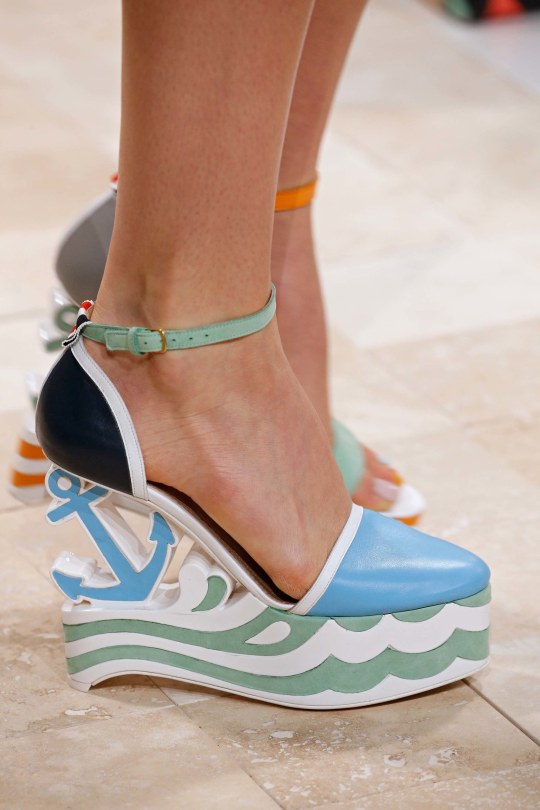

Thom Browne ready to wear spring 2017
#Thom Browne ready to wear spring 2017#Thom Browne#shoes#wedges#fashion#details#fashion details#accessories
16 notes
·
View notes
Text



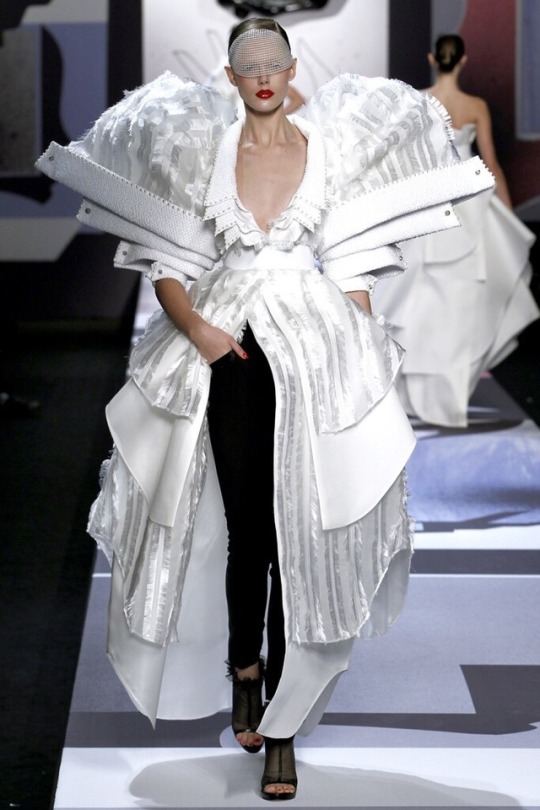
Runway deconstructivism
1: Thom Browne Fall 2017 menswear
2: Maison Margiela Fall 2017 couture
3: Comme des Garcons Fall 2012 ready-to-wear
4: Viktor & Rolf Spring 2011 ready-to-wear
#fashion#runway#couture#deconstruction#deconstructivism#thom browne#maison margiela#john galliano#comme des garcons#rei kawakubo#viktor & rolf
104 notes
·
View notes
Photo


Thom Browne ready to wear spring 2017
16 notes
·
View notes
Photo
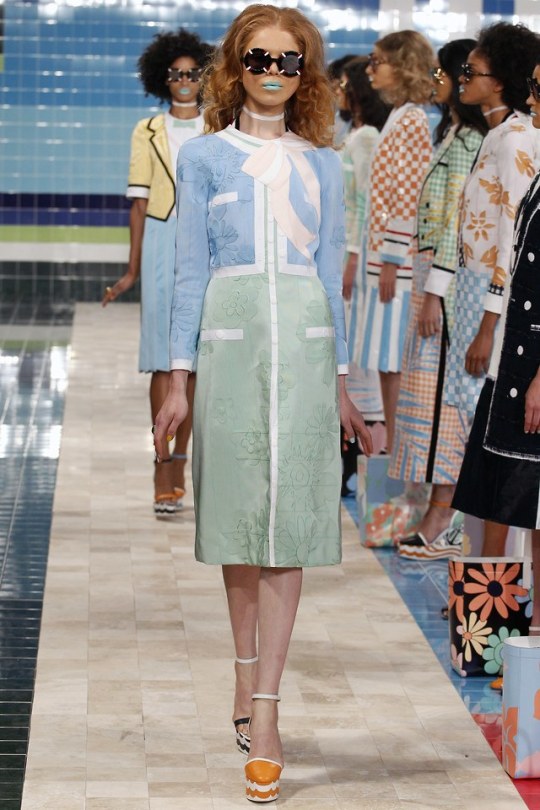
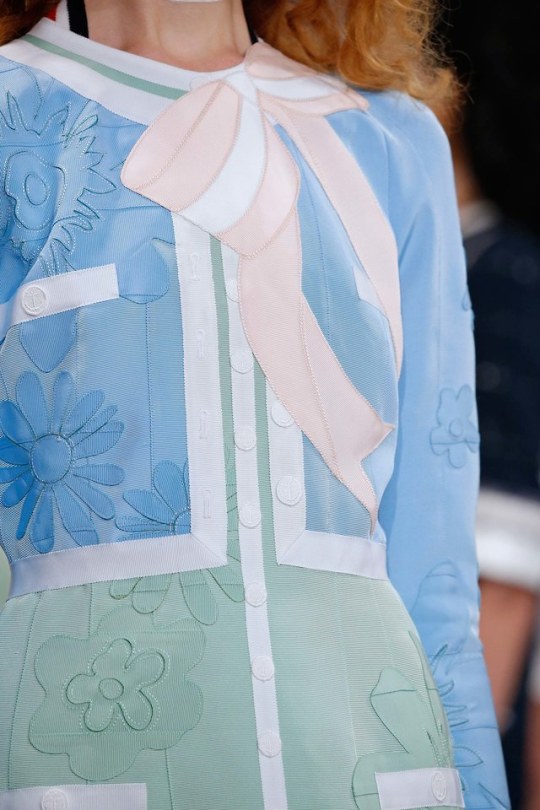
Thom Browne ready to wear spring 2017
15 notes
·
View notes
Photo


Thom Browne ready to wear spring 2017
11 notes
·
View notes
Photo
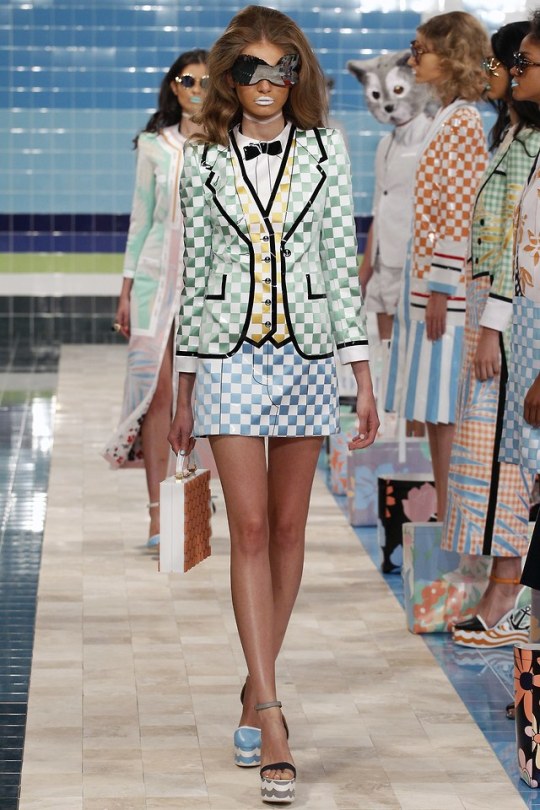

Thom Browne ready to wear spring 2017
9 notes
·
View notes